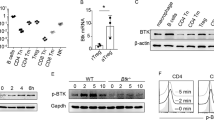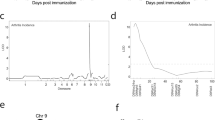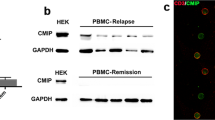Abstract
The p38 MAP kinase (MAPK) is phosphorylated and activated by upstream MAPK kinases. T cells have an alternative pathway in which T cell receptor–activated tyrosine kinase Zap70 phosphorylates p38 on Tyr323. Mice lacking Gadd45α, a small p38-binding molecule, develop a lupus-like autoimmune disease. Here we show that resting T cells but not B cells from Gadd45a−/− mice had spontaneously increased p38 activity in the absence of 'upstream' MAPK kinase activation. The p38 from resting Gadd45a−/− T cells was spontaneously phosphorylated on Tyr323, and its activity was specifically inhibited by recombinant Gadd45α in vitro. Thus, constitutive activation of T cell p38 through the alternative pathway is prevented by Gadd45α, the absence of which results in p38 activation, T cell hyperproliferation and autoimmunity.
This is a preview of subscription content, access via your institution
Access options
Subscribe to this journal
Receive 12 print issues and online access
$209.00 per year
only $17.42 per issue
Buy this article
- Purchase on Springer Link
- Instant access to full article PDF
Prices may be subject to local taxes which are calculated during checkout







Similar content being viewed by others
References
Fan, W., Richter, G., Cereseto, A., Beadling, C. & Smith, K.A. Cytokine response gene 6 induces p21 and regulates both cell growth and arrest. Oncogene 18, 6573–6582 (1999).
Fornace, A.J., Jr. et al. Mammalian genes coordinately regulate by growth arrest signals and DNA-damaging agents. Mol. Cell. Biol. 9, 4196–4203 (1989).
Vairapandi, M., Balliet, A.G., Fornace, A.J.J., Hoffman, B. & Liebermann, D.A. The differentiation primary response gene MyD118, related to GADD45, encodes for a nuclear protein which interacts with PCNA and p21WAF1/CIP1. Oncogene 12, 2579–2594 (1996).
Lu, B. et al. GADD45γ mediates the activation of the p38 and JNK MAP kinase pathways and cytokine production in effector TH1 cells. Immunity 14, 583–590 (2001).
Yang, J., Zhu, H., Murphy, T.L., Ouyang, W. & Murphy, K.M. IL-18-stimulated GADD45β required in cytokine-induced, but not TCR-induced, IFN-γ production. Nat. Immunol. 2, 157–164 (2001).
Lu, B., Ferrandino, A.F. & Flavell, R.A. Gadd45β is important for perpetuating cognate and inflammatory signals in T cells. Nat. Immunol. 5, 38–44 (2004).
Hoffmeyer, A., Piekorz, R., Moriggl, R. & Ihle, J.N. Gadd45γ is dispensable for normal mouse development and T-cell proliferation. Mol. Cell. Biol. 21, 3137–3143 (2001).
Hollander, M.C. et al. Genomic instability in Gadd45a-deficient mice. Nat. Genet. 23, 176–184 (1999).
Hollander, M.C. et al. Dimethylbenzanthracene carcinogenesis in Gadd45a-null mice is associated with decreased DNA repair and increased mutation frequency. Cancer Res. 61, 2487–2491 (2001).
Salvador, J.M. et al. Mice lacking the p53-Eefector gene Gadd45a develop a lupus-like syndrome. Immunity 16, 499–508 (2002).
Rincon, M. MAP-kinase signaling pathways in T cells. Curr. Opin. Immunol. 13, 339–345 (2001).
Salvador, J.M. et al. Alternative p38 activation pathway mediated by T cell receptor–proximal tyrosine kinases. Nat. Immunol. advance online publication, 27 February 2005 (10.1038/ni1177).
Takekawa, M. & Saito, H. A family of stress-inducible GADD45-like proteins mediate activation of the stress-responsive MTK1/MEKK4 MAPKKK. Cell 95, 521–530 (1998).
Mita, H., Tsutsui, J., Takekawa, M., Witten, E.A. & Saito, H. Regulation of MTK1/MEKK4 kinase activity by its N-terminal autoinhibitory domain and GADD45 binding. Mol. Cell. Biol. 22, 4544–4555 (2002).
Chi, H., Lu, B., Takekawa, M., Davis, R.J. & Flavell, R.A. GADD45beta/GADD45gamma and MEKK4 comprise a genetic pathway mediating STAT4-independent IFNγ production in T cells. EMBO J. 23, 1576–1586 (2004).
Weiss, L. et al. Regulation of c-Jun NH2-terminal kinase (Jnk) gene expression during T cell activation. J. Exp. Med. 191, 139–146 (2000).
Dong, C., Davis, R.J. & Flavell, R.A. MAP kinases in the immune response. Annu. Rev. Immunol. 20, 55–72 (2002).
Chang, L. & Karin, M. Mammalian MAP kinase signalling cascades. Nature 410, 37–40 (2001).
Giroux, S. et al. Embryonic death of Mek1-deficient mice reveals a role for this kinase in angiogenesis in the labyrinthine region of the placenta. Curr. Biol. 9, 369–372 (1999).
Alberola-Ila, J., Forbush, K.A., Seger, R., Krebs, E.G. & Perlmutter, R.M. Selective requirement for MAP kinase activation in thymocyte differentiation. Nature 373, 620–623 (1995).
Pagès, G. et al. Defective thymocyte maturation in p44 MAP kinase (Erk 1) knockout mice. Science 286, 1374–1377 (1999).
Bulavin, D.V., Kovalsky, O., Hollander, M.C. & Fornace, A.J.J. Loss of oncogenic H-ras-induced cell cycle arrest and p38 mitogen-activated protein kinase activation by disruption of Gadd45a. Mol. Cell. Biol. 23, 3859–3871 (2003).
Schaeffer, H.J. & Weber, M.J. Mitogen-activated protein kinases: specific messages from ubiquitous messengers. Mol. Cell. Biol. 19, 2435–2444 (1999).
Dong, C. et al. JNK is required for effector T-cell function but not for T-cell activation. Nature 405, 91–94 (2000).
Davis, R.J. Signal transduction by the JNK group of MAP kinases. Cell 103, 239–252 (2000).
Brancho, D. et al. Mechanism of p38 MAP kinase activation in vivo. Genes Dev. 17, 1969–1978 (2003).
Tanaka, N. et al. Differential involvement of p38 mitogen-activated protein kinase kinases MKK3 and MKK6 in T-cell apoptosis. EMBO Rep. 3, 785–791 (2002).
Wang, X.S. et al. Molecular cloning and characterization of a novel p38 mitogen-activated protein kinase. J. Biol. Chem. 272, 23668–23674 (1997).
Yamaguchi, K. et al. Identification of a member of the MAPKKK family as a potential mediator of TGF-β signal transduction. Science 270, 2008–2011 (1995).
Ichijo, H. et al. Induction of apoptosis by ASK1, a mammalian MAPKKK that activates SAPK/JNK and p38 signaling pathways. Science 275, 90–94 (1997).
Wang, X.S. et al. Molecular cloning and characterization of a novel protein kinase with a catalytic domain homologous to mitogen-activated protein kinase kinase kinase. J. Biol. Chem. 271, 31607–31611 (1996).
Ge, B. et al. MAPKK-independent activation of p38α mediated by TAB1-dependent autophosphorylation of p38α. Science 295, 1291–1294 (2002).
Hildesheim, J. et al. Gadd45a protects against UV irradiation-induced skin tumors, and promotes apoptosis and stress signaling via MAPK and p53. Cancer Res. 62, 7305–7315 (2002).
Gong, Q. et al. Disruption of T cell signaling networks and development by Grb2 haploid insufficiency. Nat. Immunol. 2, 29–36 (2001).
Ward, S.G., Parry, R.V., Matthews, J. & O'Neill, L. A p38 MAP kinase inhibitor SB203580 inhibits CD28-dependent T cell proliferation and IL-2 production. Biochem. Soc. Trans. 25, 304S (1997).
Matsuda, S., Moriguchi, T., Koyasu, S. & Nishida, E. T lymphocyte activation signals for interleukin-2 production involve activation of MKK6-p38 and MKK7-SAPK/JNK signaling pathways sensitive to cyclosporin A. J. Biol. Chem. 273, 12378–12382 (1998).
Zhang, J. et al. p38 mitogen-activated protein kinase mediates signal integration of TCR/CD28 costimulation in primary murine T cells. J. Immunol. 162, 3819–3829 (1999).
Haeryfar, S.M. & Hoskin, D.W. Selective pharmacological inhibitors reveal differences between Thy-1- and T cell receptor-mediated signal transduction in mouse T lymphocytes. Int. Immunopharmacol. 1, 689–698 (2001).
Allison, A.C. Immunosuppressive drugs: the first 50 years and a glance forward. Immunopharmacology 47, 63–83 (2000).
Lee, J.C. et al. Inhibition of p38 MAP kinase as a therapeutic strategy. Immunopharmacology 47, 185–201 (2000).
Kovalsky, O., Lung, F.D., Roller, P.P. & Fornace, A.J.J. Oligomerization of human Gadd45a protein. J. Biol. Chem. 276, 39330–39339 (2001).
Zhan, Q. et al. Association with Cdc2 and inhibition of Cdc2/Cyclin B1 kinase activity by the p53-regulated protein Gadd45. Oncogene 18, 2892–2900 (1999).
Acknowledgements
We thank S. Gutkind for critical review of this manuscript.
Author information
Authors and Affiliations
Corresponding author
Ethics declarations
Competing interests
The authors declare no competing financial interests.
Rights and permissions
About this article
Cite this article
Salvador, J., Mittelstadt, P., Belova, G. et al. The autoimmune suppressor Gadd45α inhibits the T cell alternative p38 activation pathway. Nat Immunol 6, 396–402 (2005). https://doi.org/10.1038/ni1176
Received:
Accepted:
Published:
Issue Date:
DOI: https://doi.org/10.1038/ni1176
This article is cited by
-
Diversity and versatility of p38 kinase signalling in health and disease
Nature Reviews Molecular Cell Biology (2021)
-
GADD45α drives brown adipose tissue formation through upregulating PPARγ in mice
Cell Death & Disease (2020)
-
Investigating RNA expression profiles altered by nicotinamide mononucleotide therapy in a chronic model of alcoholic liver disease
Human Genomics (2019)
-
The protein tyrosine kinase SYK regulates the alternative p38 activation in liver during acute liver inflammation
Scientific Reports (2019)
-
The microRNA miR-148a functions as a critical regulator of B cell tolerance and autoimmunity
Nature Immunology (2016)



